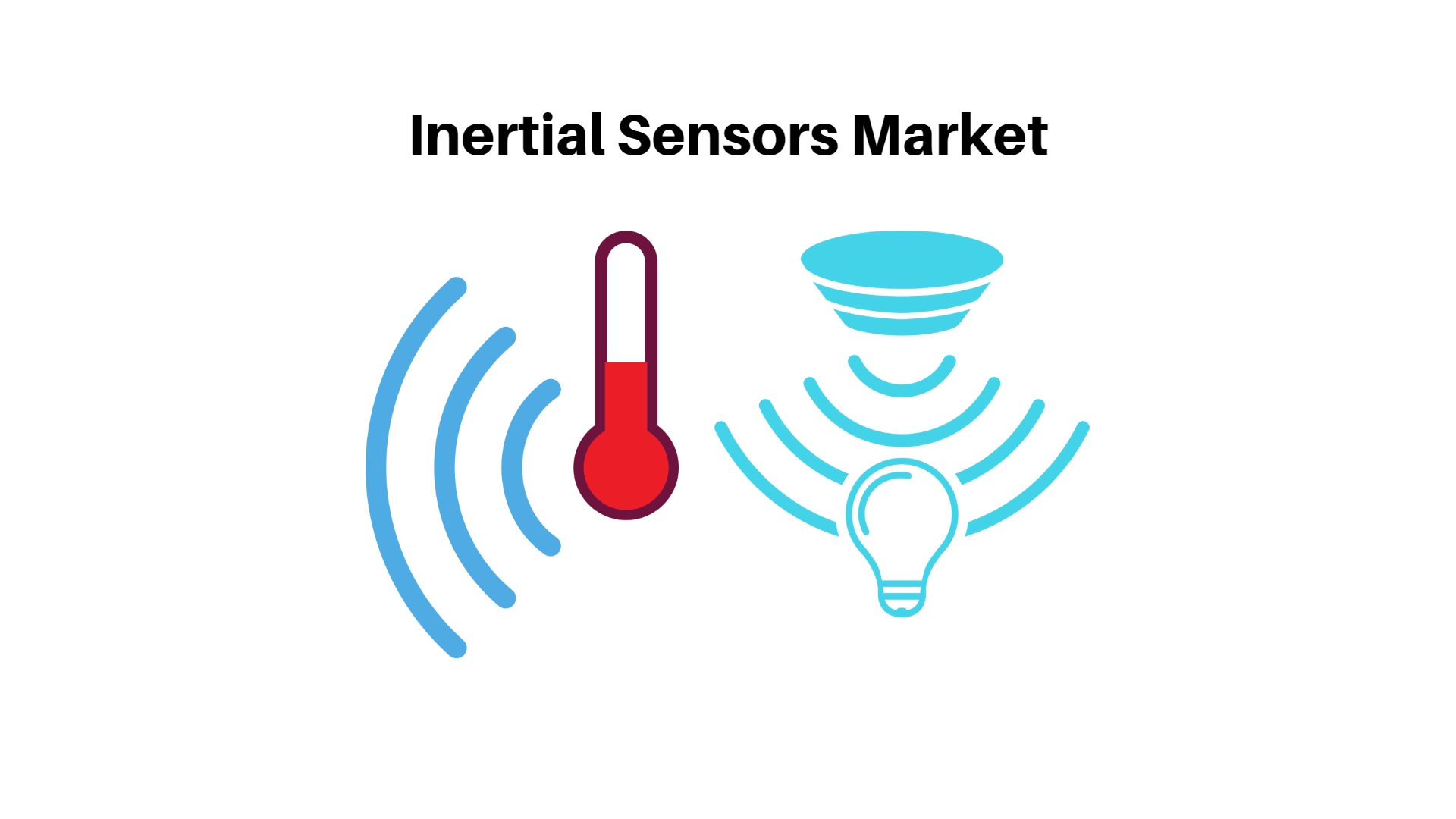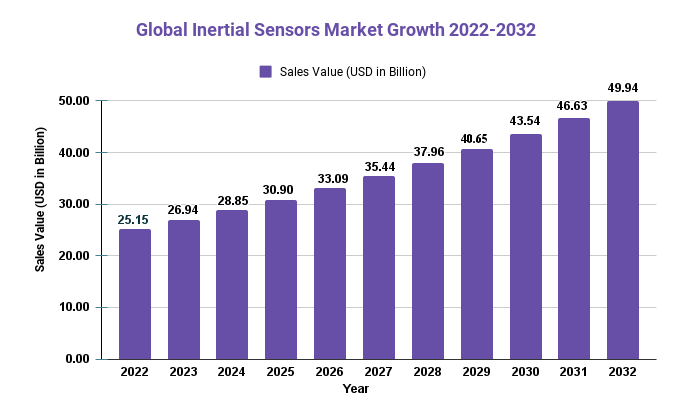Inertial Sensors Market Size USD 21.72 billion by 2032 | Impact of US Bank Failures 2023

Page Contents
Market Overview
Published Via 11Press: Market.us recently published a market research report forecasting the global inertial sensors market to grow from USD 10.94 billion in 2022 to USD 21.72 billion by 2032, at an average compound annual growth rate (CAGR) of 7.1% over the forecast period.
The global inertial sensors market has experienced impressive growth over the past few years and this trend is forecast to continue. These sensors find applications across consumer electronics, automotive, aerospace and defense, industrial processes, and healthcare. Their precise measurements of acceleration, velocity, and orientation make them indispensable components in many devices.
The Asia Pacific region is expected to lead the market during this period, driven by rising demand for consumer electronics and automotive applications.
Overall, the global inertial sensors industry is expected to witness steady growth over the coming years due to increasing demand for these sensors across a variety of applications. Asia Pacific is projected to dominate this period due to growing interest in consumer electronics and automotive solutions.
Request For Sample Report Here: https://market.us/report/inertial-sensors-market/request-sample
Key Takeaway
- The global inertial sensors market is expected to experience steady growth over the coming years, due to increasing demand for these sensors across various applications such as consumer electronics, automotive, aerospace & defense, industrial, and healthcare.
- By 2025, the market is projected to reach $13.45 billion with a compound annual growth rate (CAGR) of 7.1% over this forecast period.
- The Asia Pacific region is expected to dominate the market, due to rising demand for consumer electronics and automotive applications. Furthermore, navigation and positioning systems are playing an increasingly important role in various applications – providing a key driving factor for market expansion.

Regional Snapshot
The greatest regional market for inertial sensors in 2020 was found in North America. The main drivers of the market growth in this region are the rising use of autonomous vehicles and the rising demand for consumer electronics. The market for North American inertial sensors is expanding mostly due to the United States.
- Europe: Throughout the course of the forecast period, the market for inertial sensors in Europe is anticipated to expand significantly. The market in this area is expanding as a result of the rising demand for high-performance inertial sensors in aerospace and defense applications. The three countries that are most responsible for the market growth for inertial sensors in Europe are Germany, France, and the United Kingdom.
- Asia-Pacific: The Asia-Pacific inertial sensors market is anticipated to experience the highest growth during the forecast period. The increasing demand for inertial sensors in consumer electronics and automotive applications is fueling market development here. China, Japan, and South Korea are the major contributors to this region's expansion within this space.
- Latin America: The Latin American inertial sensors industry is expected to experience moderate growth over the forecast period. The increasing adoption of inertial sensors for aerospace and defense applications is driving market expansion in this region, with Brazil and Mexico leading the charge.
- Middle East & Africa: Throughout the course of the forecast period, it is expected that the Middle East & Africa inertial sensors industry would expand moderately. Inertial sensors are being used more frequently in defense and aviation applications, and Saudi Arabia and the United Arab Emirates are key market contributors.
Drivers
- Increased Adoption of Autonomous Vehicles: As autonomous vehicle adoption continues to rise, so too does the demand for inertial sensors – used for navigation, positioning, and motion sensing.
- Growing Demand for Consumer Electronics: The growing popularity of smartphones, tablets, and other consumer electronics is propelling the growth of the inertial sensors industry. These devices use these sensors for motion sensing, gaming, and augmented reality applications.
- Increased Adoption of Wearable Devices: As wearable devices such as smartwatches and fitness trackers become increasingly popular, the demand for inertial sensors is rising. These components enable activity tracking and motion sensing through motion detection.
- Growing Demand for Aerospace and Defense Applications: The increasing need for high-performance inertial sensors in aerospace and defense applications such as navigation, guidance, and stabilization systems is fueling the growth of this market.
- Recent Advances in MEMS Technology: Recent improvements to micro-electro-mechanical systems (MEMS) technology have allowed the miniaturization of inertial sensors, making them more compact, dependable, and cost-effective.
- Precision Agriculture Is Growing Popular: Inertial sensors are increasingly being employed in precision agriculture applications like crop mapping and yield monitoring to increase yields and cut costs.
- Industrial automation is on the rise: Inertial sensors are being employed in applications like robotics and machine control to boost productivity while cutting costs.
Restraints
- High Cost: Inertial sensors can be costly, which may limit their use in certain applications due to complex manufacturing processes and the use of premium materials.
- Limited Accuracy: Inertial sensors lack accuracy when compared to other types of sensors such as GPS. This limitation could potentially hinder their use in applications that demand high precision.
- The complexity of Integration: Inertial sensors may prove challenging to integrate into certain applications, such as autonomous vehicles, due to their intricate nature and need for calibration.
- Reliability Limitation: Inertial sensors may be affected by environmental elements like temperature and humidity, potentially compromising their accuracy in certain applications.
- Limited Sensing Range: Inertial sensors have a limited sensing range, which could restrict their application in applications that require long-distance sensing.
- Competition from Alternative Technologies: Inertial sensors may face competition from other types of sensors, such as optical and radar, which could limit their adoption in certain applications.
- Regulatory Barriers: Inertial sensors used in certain applications, such as aerospace and defense, may be subject to stringent regulatory requirements that could restrict their adoption or increase their cost.
Opportunities
- Increasing Demand for Autonomous Vehicles: The growing popularity of autonomous vehicles presents an exciting opportunity for the inertial sensors industry. These sensors are essential components in autonomous vehicles and aid with navigation, positioning, and motion sensing.
- Growing Demand for Drones: With the growing use of drones in applications like agriculture, surveillance, and delivery, there is an opportunity for inertial sensor manufacturers. Drones rely on inertial sensors for navigation and stabilization purposes.
- Advancements in MEMS Technology: The development of micro-electro-mechanical systems (MEMS) has created new opportunities for the inertial sensors market. MEMS-based inertial sensors are smaller, more dependable, and less expensive than traditional sensors.
- A huge opportunity exists in the market for inertial sensors as a result of the rising demand for autonomous vehicles. Autonomous cars must include inertial sensors since they are essential for motion detection, location, and navigation.
- Increasing drone use in numerous applications, including delivery, surveillance, and agriculture, creates a market opportunity for inertial sensors. Drones use inertial sensors for stability and navigation.
- Improvements in MEMS technology: The market for inertial sensors now has more prospects because of the development of MEMS technology. In comparison to conventional sensors, MEMS-based inertial sensors are more compact, dependable, and affordable.
View Detailed TOC of the Report | https://market.us/report/inertial-sensors-market/table-of-content/
Challenges
- Intense Competition: The inertial sensors industry is highly competitive, featuring many established players and new entrants. This fierce competition could negatively affect market growth and profitability.
- Technological Limitations: Inertial sensors have inherent shortcomings when it comes to accuracy, dependability, and sensing range. These drawbacks may restrict their application in certain circumstances and limit their growth potential.
- Cost Pressures: Inertial sensors can be costly, and cost pressures from customers and competitors could negatively affect market growth and profitability.
- Supply chain disruptions: The inertial sensors market relies on intricate supply chains that may be disrupted by natural disasters, geopolitical tensions, and trade policies. Such disruptions could significantly impact market growth and profitability.
- Cybersecurity Risks: Inertial sensors may be vulnerable to cybersecurity risks like hacking and data breaches. These incidents could erode customer confidence and restrict market expansion.
- Regulatory Barriers: The inertial sensors industry is subject to various regulations such as safety and environmental standards that could constrain market expansion or drive up costs.
- Integration Challenges: Inertial sensors may prove challenging to integrate into certain applications, such as autonomous vehicles, due to their complex nature and requirement for calibration. Integration issues could significantly impede market growth and restrict the adoption of inertial sensors.
Recent Developments
- Advances in MEMS Technology: MEMS-based inertial sensors are becoming more and more popular due to their small size, low power consumption, and cost-effectiveness. MEMS technology is opening up new applications and fueling growth within the market.
- Increasing Demand for Autonomous Vehicles: The growing interest in autonomous vehicles is spurring the development of advanced inertial sensor technologies. Manufacturers are striving to produce sensors that are more precise, dependable, and robust so as to meet the requirements of this rapidly-evolving market.
Key Market Segments
Type
- Attitude Heading and Reference Systems (AHRS)
- Inertial Navigation Systems/Inertial Navigation Units (INUs)
- Inertial Measurement Units (IMUs)
Application
- Transportation
- Agriculture
- Healthcare
- Commercial
- Aerospace
- Defense
Key Market Players
- Kongsberg Gruppen
- Trimble Navigation
- AKM
- Bosch Sensortec
- InvenSense
- STMicroelectronics
- NXP
- First Sensor
- Advanced Navigation
- Epson Electronics
- VectorNav Technologies
- InnoVista Sensors
- TE Connectivity
- AOSense
Report Scope
| Report Attribute | Details |
| The market size value in 2022 | USD 10.94 Bn |
| Revenue forecast by 2032 | USD 21.72 Bn |
| Growth Rate | CAGR Of 7.1% |
| Regions Covered | North America, Europe, Asia Pacific, Latin America, and Middle East & Africa, and Rest of the World |
| Historical Years | 2017-2022 |
| Base Year | 2022 |
| Estimated Year | 2023 |
| Short-Term Projection Year | 2028 |
| Long-Term Projected Year | 2032 |
Frequently Asked Question
Q: What is the current market size for the Inertial Sensors Market?
A: According to a report by Market.us, the Inertial Sensors industry was valued at USD 10.94 billion in 2022 and is expected to reach USD 21.72 billion by 2032, growing at a CAGR of 7.1% during the forecast period.
Q: What are the key segments of the Inertial Sensors Market?
A: The Inertial Sensors Market can be segmented based on Type (Attitude Heading and Reference Systems (AHRS), Inertial Navigation Systems/Inertial Navigation Units (INUs), Inertial Measurement Units (IMUs)), By Application (Transportation, Agriculture, Healthcare, Commercial, Aerospace, Defense)and geography (North America, Europe, Asia-Pacific, Latin America, and Middle East & Africa).
Q: Who are the key players in the Inertial Sensors Market?
A: Some of the key players in the Inertial Sensors Market include Kongsberg Gruppen, Trimble Navigation, AKM, Bosch Sensortec, InvenSense, STMicroelectronics, NXP, First Sensor, Advanced Navigation, Epson Electronics, VectorNav Technologies, InnoVista Sensors, TE Connectivity, AOSense.
The team behind market.us, marketresearch.biz, market.biz and more. Our purpose is to keep our customers ahead of the game with regard to the markets. They may fluctuate up or down, but we will help you to stay ahead of the curve in these market fluctuations. Our consistent growth and ability to deliver in-depth analyses and market insight has engaged genuine market players. They have faith in us to offer the data and information they require to make balanced and decisive marketing decisions.